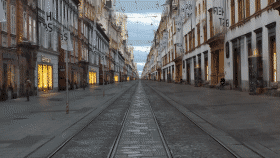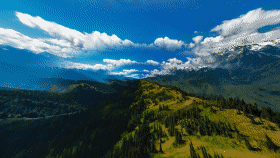- Home
- After Effects
- Discussions
- Re: Creating an infinite zoom with just one scene/...
- Re: Creating an infinite zoom with just one scene/...
Copy link to clipboard
Copied
Hi, I'm looking to create an "infinite zoom" but it's just an endless loop of one location/scene. When I searched for tutorials and help on this, all I could find is a zoom through multiple scenes/images/locations, which is not what I'm looking for.
What I'm thinking of is something more like this :


I found an infinite hallway tutorial where you build a 3D box of sorts using a photo and perspective tools, but I don't know if I can do that with nature or city scenery like the above GIFs.
 1 Correct answer
1 Correct answer
Open the image in Photoshop. Pick a section of the image that you can repeat, create a layer mask to remove the background part of the foreground section you are going to repeat, Then scale the bottom copy down and do whatever retouching you need to do to create a nearly invisible seam between the repeated section and the original layer.
Import this image into AE, make the layer 3D, animate the camera so that it moves straight in on the image until you get to the same framing as the duplicate
...Copy link to clipboard
Copied
The methodology doesn't really differ regardless whether it's multiple images or just a repeating one. The examples you used even only seem to employ the simplest zoom method of scaling the images with the mountain one only having an overcranked fake lens distortion thrown on. The rest is really just figuring out the timing of e.g. three duplicate layers and then finding matchingt start and end points. It's not black magic, just a bit of trial and error to create the illusion.
Mylenium
Copy link to clipboard
Copied
Open the image in Photoshop. Pick a section of the image that you can repeat, create a layer mask to remove the background part of the foreground section you are going to repeat, Then scale the bottom copy down and do whatever retouching you need to do to create a nearly invisible seam between the repeated section and the original layer.
Import this image into AE, make the layer 3D, animate the camera so that it moves straight in on the image until you get to the same framing as the duplicate part, set the out point for the camera and the image layer, pre-compose both layers, enable Time Remapping, go to the last time-remapping keyframe, then move back one frame and set another one, delete the last TR keyframe and add a loopOut() expression.
Extend and move the outpoint of the time-remapped nested comp to make the infinite zoom as long as you want.
Another option is to set the work area to one frame shorter than the perfect matching frame, trim the comp to the work area, then use Composition/Pre-render to render a production-quality master video that you can loop using footage interpretation in AE or Premiere Pro.
The hardest part of the whole process is creating the Photoshop master, which has a repeated section that is seamless. When you get that part done, the rest is pretty easy. The most difficult part of the duplicate section process is matching the perspective. It's pretty easy with landscapes but more difficult with urban shots. You will be in pretty good shape if you can match up about the first third of the frame.
The Vanishing Point tool in Photoshop can help with the build.
Copy link to clipboard
Copied
Thanks for the detailed answer. You're right, making the initial edits and getting the zoom to cut off at the right section is very tough, but I'll keep trying.
Copy link to clipboard
Copied
Find more inspiration, events, and resources on the new Adobe Community
Explore Now
